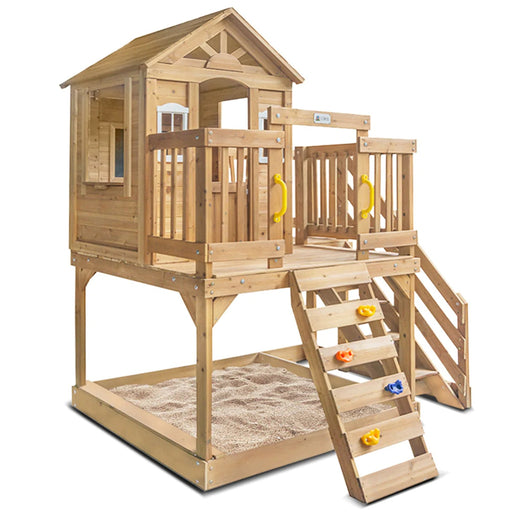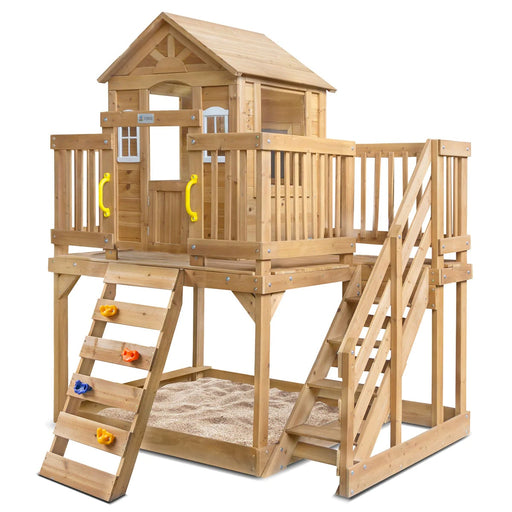Why a Cubby House?
Because kids don’t need four walls and a screen to have fun — they need a secret hideout, a pirate ship, a fairy castle, or a backyard café. Cubby houses are little spark-plug zones for big imaginations, and they do wonders for getting kids outside and off the couch.
They’re not just for play either — cubbies help kids develop independence, confidence, and creative problem-solving skills (like how to turn a shoe into a phone or a stick into a spoon). Plus, they encourage active outdoor play — which means fewer sugar-fuelled laps around your lounge room. Want to know why outdoor play matters? Nature Play Australia has some great insights.
Cubby houses can also be social hotspots. Whether it's siblings playing make-believe or the whole neighbourhood joining in for “cubby club,” they’re fantastic for building friendships, sharing, and sorting out who’s in charge of the snack shop.
If you're toying with the idea of adding one to your backyard, you're in the right place. At All Things For Kids, we’ve got a whole range of cubby houses that tick the fun box and the practical one.
This guide will walk you through everything you need to know — from must-haves to nice-to-haves — so you can find a cubby that suits your space, your family, and your kids' wildest dreams.
What Age Is a Cubby House Best For?
Toddlers (Ages 2–4)
For the littlest adventurers, go for something low to the ground and easy to navigate — think plastic cubby houses or compact wooden ones. Look for wide doorways, gentle ramps, and no tricky steps. Bonus points if it comes in bright colours or fun shapes!
Big Kids (Ages 5+)
As kids grow, so does their sense of adventure. Bigger timber cubbies with slides, climbing walls, or even elevated platforms start to become serious fun. These setups encourage creative play and get them burning energy while imagining they’re running a café, sailing a ship, or building their own clubhouse empire.
At All Things For Kids, we’ve got a massive range of cubby houses from different brands — from cute little starter cubbies to full-on backyard fortresses. Whatever your kid’s age or imagination level, there’s something to match.
📌 Pro tip: Always double-check the product’s recommended age and weight limit — better safe than a wobbly cubby!
Types of Cubby Houses
Not all cubbies are created equal — some are simple and sweet, others are mini adventure parks. Here’s a breakdown of the different styles you'll find (yes, we stock the lot):
Plastic Cubby Houses
Lightweight, easy to move, and usually bursting with bright colours — plastic cubbies are perfect for toddlers who are just starting to explore. They’re low to the ground and fuss-free, making them ideal for supervised backyard play.
Wooden Cubby Houses
These are the classic go-to for style and sturdiness. Wooden cubbies blend beautifully into the backyard and are built to last. Many come with add-ons like verandas, windows, and even flower boxes. Super cute, super timeless.
Elevated Cubby Houses
Got a little daredevil on your hands? Elevated cubbies bring the adventure, with stairs, climbing walls, and slides that let kids burn energy and play high up in their own mini treehouse-style retreat.
Cubby Houses with Slides, Swings & Monkey Bars
Why stop at four walls when you can add a playground into the mix? Combo cubbies are a parent-favourite — they come with built-in slides, swings, monkey bars and even sandpits. It’s a backyard game-changer that gets kids moving and keeps boredom at bay.
Size & Space: What Will Fit in My Backyard?
Measuring Up
Before you fall in love with that dream cubby house, let’s talk space — because no one wants to be the parent who bought a playground palace that doesn’t fit through the gate.
Start by grabbing a tape measure and checking the area where you plan to place the cubby. Make sure it’s flat, stable, and away from hazards like fences, pools, or low-hanging branches. Measure the width, depth, and don’t forget the height — especially for elevated cubbies.
Allow for Clearance
We always recommend leaving at least 1 to 2 metres of clear space around the cubby house. This gives kids room to run, climb, and swing without smashing into the fence — and it’s a safety win too.
Small Yard? No Worries
If you’ve got a smaller backyard, courtyard, or even a townhouse setup, there are loads of great options. Compact wooden cubbies and plastic cubbies are perfect space-savers, and some models even have multi-functional features like built-in storage or fold-down benches.
At All Things For Kids, we’ve got cubbies for backyards big and small — just filter by size or reach out and we’ll help you find the right fit.
Do I Need Council Approval?
In most areas, cubby houses don’t require council approval — especially if they’re under 3 metres high and not being used as a permanent structure. That said, it’s always a good idea to double-check with your local council or planning department, especially for elevated cubbies or if you live in a heritage zone.
Here are some handy links to check your state’s guidelines:
- Queensland – QLD Government Building Approvals
- New South Wales – NSW Planning Portal
- Victoria – VIC Planning Permits Guide
- South Australia – PlanSA: Before You Lodge
- Western Australia – Department of Planning, Lands and Heritage
None of cubby houses we have sold across Australia have required our customers to need council approval — but it’s always better to be safe than sorry.
Assembly: DIY or Let Us Take Care of It For You?
Let’s be honest — not everyone gets excited about power tools on the weekend. The good news? Most of our cubby houses come partially assembled, and many families find the setup surprisingly doable. But if DIY isn’t your thing, we’ve got you covered.
Can You Do It Yourself?
Yep, in most cases you can. Many of our cubbies arrive with pre-built panels — like walls and roofs — so it’s more like slotting together a giant puzzle than starting from scratch. You’ll need a cordless drill, a couple of hours, and probably a second pair of hands (especially for the bigger or elevated models). Want a better idea of what it takes? Check out our Cubby House Assembly Guide for a handy breakdown.
Want to Skip the Tools Altogether?
Here’s where we’re different. Unlike most retailers, we offer assembly services across Australia. Whether you're in a metro area or way out in the sticks, we can help get your cubby up and ready for play — no sweat, no stress.
What Comes Pre-Built?
Each product varies, but many of our brands pre-assemble key sections (like side walls, roofs, and floors), so you’re not stuck figuring out how to line up 57 timber slats. Just check the product page for specific assembly info, or reach out and we’ll give you the lowdown.
Fun Features to Consider
A cubby house can be more than just four walls and a roof — the real magic is in the extras. Think slides for speedy escapes, swings for sky-high daydreaming, and telescopes for spotting pirates (or the family dog).
Want to turn your backyard into a mini adventure park? Look for cubbies with built-in blackboards for doodles and secret messages, verandas for tea parties in the shade, and even sandpits for digging to the other side of the world.
Here are a few favourites from our range to get your imagination rolling:
- The Delightful Shack – comes with a slide and a roomy veranda
- The Warrigal – our all-rounder with monkey bars, slide, and sandpit combo
- Cubby Houses with Swings – because one swing is never enough
Mix and match the features that make sense for your space (and your little legends), and you’ll have a cubby that’s more than a playhouse — it’ll be the place to be.
Maintenance Tips: Keep Your Cubby Looking Fresh
Cubby houses are built for fun — and with a little TLC, they’ll stay safe, sturdy, and looking great for years. Here’s how to keep yours in top shape:
For Wooden Cubby Houses
- Seal the Deal: We recommend applying a weatherproof sealant or exterior paint to protect the timber from the Aussie sun and surprise rainstorms.
- Touch-Up Time: Keep an eye out for any paint chips or fading, and re-coat as needed to prevent weather damage.
- Winter Wrap-Up: If you’re in a wet or cold area, consider covering your cubby in the off-season or during heavy downpours.
For Plastic Cubby Houses
- Easy Cleaning: Just grab a sponge, bucket of soapy water, and give it a good scrub every so often. Hose it down and let it dry in the sun — too easy.
- Keep it Shady: UV can fade bright colours over time, so if possible, place it in a shaded part of the yard.
General Maintenance
- Check the Hardware: Every few months, tighten bolts, check screws, and look for any signs of wear and tear — especially on moving parts like doors or monkey bars.
- Clear the Ground: Make sure the area around the cubby is free from sharp objects, rocks, or anything that could turn a tumble into a bruise.
A little upkeep goes a long way — and keeps the fun rolling without interruptions.
Cubby House FAQs
Is a cubby house safe for toddlers?
Yes — especially the plastic and low-profile wooden models designed specifically for little ones. Just make sure you choose one suited to their age group and always check the weight limit. Bonus points if you place it on soft ground like grass or rubber mats.
Can I move the cubby later?
You can, depending on the size and design. Plastic cubbies are a breeze to move. Wooden ones? Not so much. While some smaller models can be shifted with a helping hand (or two), larger setups may require a full disassemble-and-rebuild situation.
Do cubby houses come with flooring?
Some do, some don’t. Many wooden cubbies include timber floors, but others are designed to sit straight on grass or a concrete slab. You’ll find the flooring info listed on each product page at All Things For Kids — or just ask us and we’ll sort you out.
Time to Find *The One*
Ready to find your little one’s dream hideaway? Whether you’re after slides, swings, sandpits or all of the above — we’ve got a cubby house to suit every backyard (and every kid’s wild imagination).
Browse our full range of cubby houses — designed for Aussie families who know that great play doesn’t need a screen.
Shop Our Cubby Houses
Lifespan Kids Wooden Silverton Cubby House
Silverton Cubby House by Lifespan Kids The Silverton Cubby House is a versatile outdoor play space designed to keep kids active and engaged. It fea...
View full detailsLifespan Kids Warrigal Cubby House
Lifespan Kids Warrigal Cubby House with Slide & Veranda Bring a relaxed, sun-soaked charm to your backyard with the Lifespan Kids Warrigal Cubb...
View full detailsKidzShack Caboodle Shack Cubby House (with Mud Kitchen & Slide)
Caboodle Shack Cubby House – A Backyard Adventure Awaits! If your kids love cooking up soggy “soups” in the dirt, zooming down a slide and runnin...
View full detailsKidzshack Delightful Shack Cubby House
Delightful Shack Cubby House by Kidzshack As any parent knows, getting kids to play outside can be tricky in a world full of electronic entertainme...
View full detailsKidzshack Lovely Shack Cubby House
Kidzshack Lovely Shack Cubby House – Where Adventure Begins! Give your child the gift of imagination with the Lovely Shack Cubby House by Kidzshac...
View full details









